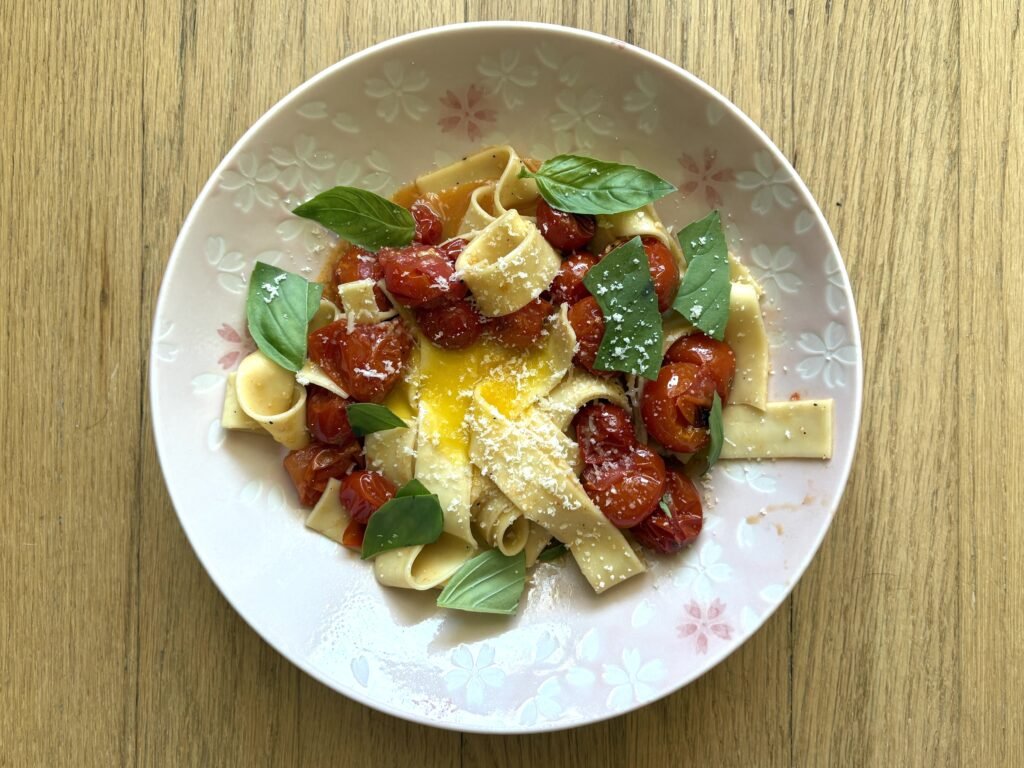

Although I myself am not a vegetarian, I can acknowledge the value in reducing my meat consumption for a variety of reasons: personal health, animal welfare, and environmental impact are some I can name off the top of my head. But beyond that, there is something to be said about the magic of cooking sans meat and discovering recipes that are wonderfully vibrant and show off the power of ingredients like fresh produce, cheese, eggs, and fragrant herbs. The idea that cooking and eating without meat will be boring is a tired one, and these vegetarian recipes beloved by Eater staff are proof.
Shakshuka
Deb Perelman, Smitten Kitchen
It’s hard to find meatless recipes that aren’t pasta-based, and as someone whose stomach is not happy if she eats a ton of bread every day, it’s sometimes a struggle to figure out how to lessen my meat intake without causing other dietary distress. This is why shakshuka is a savior. The North African dish of eggs poached in a peppery tomato sauce is hearty, flavorful, incredibly easy to make, and also adapts well to riffing. I mostly use Smitten Kitchen’s recipe, but I add other vegetables, change up the herbs and spices depending on what I have around, and occasionally remove the feta cheese if I don’t feel like a dose of dairy. It says to serve it with pita, but it also works well over rice or other grains, or just on its own like an eggy tomato stew. — Jaya Saxena, correspondent
Savory Kale and Tempeh
Rochelle Bilow, Bon Appétit
As much as I love tofu, I understand why some people — particularly those looking for a meat replacement — can struggle with its texture: It requires a little more manipulation in order to achieve a meat-like density and level of textural variation. For those people, might I suggest tempeh, the fermented protein from Indonesia? The commercial versions you’ll find at major grocery stores are usually soybean-based and have a dense, hearty texture, straight out of the package. This (vegan!) tempeh-and-kale recipe was my gateway into tempeh, and it’s still the dish I turn to the most often. Crumbling the tempeh into chunks by hand results in bite-sized pieces with craggy corners and lots of texture. In just a few minutes, it’s crispy on the outside, nice and chewy on the inside. Fermentation gives the soybeans a pleasant, nutty flavor, so this dish doesn’t need much to be delicious. — Bettina Makalintal, senior reporter
Vegan Cacio e Pepe
Alexa Weibel, NYT Cooking
Alexa Weibel’s vegan cacio e pepe recipe is one of those great back-pocket recipes that’s tailor-made for weeknight cooking: It requires only six ingredients, one pot, and less than 20 minutes of effort. I’ve lost track of how many times I’ve made it, but I can say that it has caused a 1,000-fold increase in my household’s cashew butter consumption. The cashew butter, along with miso and nutritional yeast, forms the foundation of the ersatz cheese, to which you add ladles of starchy pasta water to create a silky sauce. The combination yields a very cheese-like flavor, while a tablespoon of cracked pepper more than fulfills the “pepe” part of the equation. And while I have happily eaten this on its own, it also works well with vegetables — I like stirring sauteed kale and/or broccoli into it. If you don’t have cashew butter, you can substitute tahini; if you’re wary of salt, you can leave out some or all of the miso and just add salt to your taste. In other words, it is very, very hard to go wrong here. Whether you’re vegan or not, this is a dish that can truly be said to be a godsend to weeknight cooks everywhere. — Rebecca Flint Marx, Eater At Home editor
Mushroom Bourguignon
Melissa Clark, NYT Cooking
After the meat-cheese-booze self-pity fest of 2020 and 2021, I have spent much of past several years trying to remind myself that vegetables (and optimism) are a thing. I’ve added a number of easy, quick, plant-based recipes to my repertoire, but sometimes dinnertime calls for a project. This mushroom bourguignon recipe is what I’d call moderately fussy, with lots of time spent chopping and searing and browning and braising, but the results are nothing short of restaurant-quality. As a main course, this dish is stunning. I’ve served it at dinner parties, to my deeply carnivorous parents, and even on Valentine’s Day to rave reviews. Do not skip the final crisping of mushroom slices to garnish the top. And while the recipe calls for a side of potatoes or pasta, I love to spoon it over a thick pile of stone-ground polenta. — Lesley Suter, special projects director
Creamy Cauliflower Pasta With Pecorino Bread Crumbs
Alison Roman, NYT Cooking
In a world where cauliflower has replaced all of your beloved carbs — from rice to pizza crust to tater tots — the versatile vegetable plays only a supporting role in this creamy, carby, comforting pasta dish from Alison Roman. Here, cauliflower and shallots are melted down along with the heavy cream and bitey pecorino to make a decadent sauce that sticks to every ridge of the pasta. The breadcrumb topping, which is made with lemon zest, chives, red pepper flakes, and pecorino, adds the perfect amount of brightness and texture. I often use cascatelli pasta (you can see how it’s made in our video!) instead of rigatoni so that I can scoop up all the creamy goodness of this dish, but any tube-ish pasta will do. — Terri Ciccone, deputy director of audience development
Charred Cherry Tomato Pasta
Kevin Pang, NYT Cooking
Tomato pasta recipes are a dime a dozen, but I specifically love Kevin Pang’s version for two reasons. For starters, instead of just tossing cherry tomatoes into a pan, this recipe calls for broiling them. The skin becomes charred and toasted and you can hear the musical symphony of tomatoes popping in the oven as they cook. Once the tomatoes are blistered and reduced into a jammy sauce, you add garlic and butter before tossing pappardelle noodles into the mixture. The pasta is then finished with a shower of Parmesan, torn basil leaves, and the ingredient that really sets this dish off: a whole egg yolk. When you crack the egg yolk and toss everything together, it creates a sauce so lush and rich that I’ve been known to drink it (and you will want to, too). — Kat Thompson, associate editor of Eater at Home


